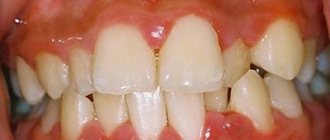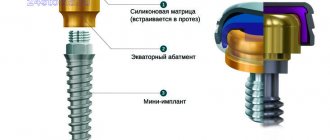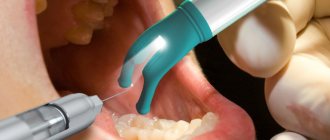Physiotherapeutic techniques are widely used in medical practice, as they contribute to the patient’s recovery and prevent the development of undesirable consequences from the disease. In clinical practice, methods based on the positive effect of electric current on the human body are often used. Fluctuarization in physiotherapy involves the effect of a sinusoidal pulse current with a low frequency on internal organs and skin. The method is widely used in modern medicine, in particular dentistry. It is important to note that the physiotherapy procedure can be carried out both in a hospital or clinic, and at home after being prescribed by a doctor.
Fluctuarization is an auxiliary treatment method used as part of complex therapy in dentistry and other fields of medicine.
About the method
The mechanisms of action of fluctuarization are similar to amplipulse therapy and diadynamic therapy. Such physiotherapy differs from these procedures in having a “softer” effect on the tissues of the body, since the electric current is characterized by asynchrony, aperiodicity and randomness of impulses, thereby allowing it to have a therapeutic effect with an insignificant influence.
In addition, the use of the method shows high efficiency compared to other types of physical treatment. This is due to the fact that during an asynchronous effect on the body’s cells, a change in their work is observed after the first procedure.
Fluctuarization in dentistry and other areas of medicine makes it possible to have a complex effect on the human body:
- pronounced anti-inflammatory and anti-edematous effect;
- increasing the speed of blood flow and outflow of lymphatic fluid from tissues;
- reduction in the severity of pain.
The large number of positive effects from the use of the procedure determines its use as part of complex treatment for a large number of patients with various pathologies.
Selecting patients for physical therapy
All treatment methods are associated with the risk of side effects or ineffective use. In order to achieve maximum effect from the use of therapeutic procedures, doctors follow certain indications and contraindications when prescribing them. It is recommended to prescribe fluctuarization (flyuktuorizaciya) for the following conditions:
- degenerative changes in intervertebral discs with the development of osteochondrosis and radicular syndrome;
- arthritis and arthrosis of any cause;
- diseases of the peripheral nervous system;
- dental pathology: pulpitis, periodontitis, alveolitis and pain after tooth extraction;
- postoperative rehabilitation;
- diseases in gynecology.
In addition to the indications, doctors should also observe contraindications for fluctuarization for successful therapy:
- benign or malignant tumors;
- serious condition of patients due to pathology of internal organs;
- disruption of hemostasis;
- increased body temperature, including with an unknown cause;
- presence of a pacemaker or other metal devices;
- intolerance to electric current;
- impaired skin sensitivity.
If any of these contraindications are identified, fluctuarization should not be used. Otherwise, there is a high risk of progression of concomitant pathologies.
Phonophoresis in dentistry
With phonophoresis, the medicine is applied to the surface of the affected organs and injected into the deep layers of tissue using ultrasound.
Indications for phonophoresis
- Ultrasound enhances the effect of antispasmodics and analgesics, so phonophoresis is used to relieve pain after treatment of caries, pulpitis, and tooth extraction;
- Treatment of lymphadenitis;
- Postoperative rehabilitation and scar treatment.
Phonophoresis gives effect after 1-2 procedures. To treat scars and recover after surgery, a course of 5-10 procedures is required.
Contraindications for phonoresis
- Metabolic diseases;
- Acute inflammatory diseases;
- Benign tumors and oncological diseases;
- Facial nerve paralysis.
All methods of physiotherapy are contraindicated in the 2nd and 3rd trimesters of pregnancy.
Sources:
- Personal experience as a dentist;
- Therapeutic dentistry / M.: Geotar-Media, 2012;
- Therapeutic dentistry: textbook: in 3 parts. Part 3. Diseases of the oral mucosa, ed. prof. G. M. Barera. — Moscow: GEOTAR-Media. – 2010;
- Prevention of dental diseases. / Kuzmina E.M. Textbook, publishing house "Poly Media Press" 2001;
- Techniques and methods of physiotherapeutic procedures, ed. Prof. V.M. Bogolyubova. Moscow, 2003;
- Bogolyubov V.M., Ponomarenko G.N. - General physiotherapy. - M., St.-Pb. - 2007;
- Bogolyubov V.M. - Technique and methodology for conducting physiotherapeutic procedures. - M. - 2002;
- Efanov O. I.; Sukhanova Yu. S. - Therapeutic electrophoresis in dentistry. - St. Petersburg. - 2002;
- Muravyannikova Zh. G. - Fundamentals of dental physiotherapy. - Rostov-on-Don. - 2002;
- Ebisu, S. Oral Biofilms and bone resorption / S. Ebisu, Y. Noiri // Clin. Calcium. - 2007;
- Myers, T.D. Lasers in dentistry. Their application in clinical practice / TDMyers // J. Amer. Dent. Ass. — 1991.
Types of electrotherapy
Fluctuarization is a method of physiotherapy that involves the effect of electric current on the human body. In this case, the current can have different shapes, which determines its biological effects.
Before performing a physical procedure, the attending physician carefully explains to the patient the course of treatment, as well as its possible risks.
Alternating current with symmetrical pulses is characterized by a constant change of positive and negative polarity. According to the instructions for the equipment, this type of current has the greatest depth of penetration deep into the body, and therefore is used to treat diseases of internal organs, blood vessels and diseases of the musculoskeletal system.
The bipolar type of current differs from the previous one in that the impulses are always negative. This type of physiotherapy allows the use of fluctuarization as medicinal electrophoresis, combining the effects of electric current with the use of drugs if there are indications for their use.
Rectified currents with one polarity have the ability to fluctuate in amplitude and frequency. This causes their galvanic effect, as a result of which the tissues begin to fluctuate. The procedure can also be supplemented with the use of medications.
Existing devices from different manufacturers have different fluctuarization modes. The choice of a specific type of current, as well as the frequency and duration of the procedure, is selected only by the attending physician.
Operating principle
Passing through the blood and lymph of human tissue, an electric current of a certain strength causes muscle fibrillation, expressed in their chaotic twitching.
In this case, the temperature of the oral mucosa rises by approximately 0.4°C, and metabolic processes are activated in the lesions, leading to a number of pronounced therapeutic effects:
- Pain relief . It is caused by the “quenching” of pain impulses due to a decrease in the excitability of the nerves when an electric current passes through them.
- Reduction or complete elimination of inflammation .
Under the influence of an electrical signal, lymph and blood flow are activated, leading to stimulation of enzyme activity and phagocytosis. Inflammation is reversed, swelling decreases due to resorption of the infiltrate, purulent foci are delimited from the “healthy” tissue and begin to shrink. Fistula tracts that drain pus may form. The end result is resolution of inflammation. - Regeneration (reparation) of affected tissues. Increased circulation of lymph and blood accelerates metabolic and regenerative processes, leading to rapid healing of the wound.
- Local myostimulation , increasing the functional state of muscles.
- Increasing trophism . There is an improvement in tissue nutrition, leading to their accelerated recovery.
As the current intensity increases (within certain limits) and the number of sessions increases, the therapeutic effect usually increases.
Therapy devices
In clinical practice, a large number of instruments are used to carry out the procedure. The most famous device for fluctuarization is “ASB-2-1”, however, in recent years its use has decreased significantly due to the need for additional grounding of the device during operation.
The most frequently used devices in clinical practice are: therapeutic equipment “FT-30-05” and “ASB-2M”, a device used in dental practice “FS-100”. The latter device is often used to combat toothache and to treat inflammatory gum diseases. ASB-2M differs from its analogues in its ability to use various types of electric current and modes of exposure.
The choice of a specific device for physiotherapy is determined by the attending physician depending on the patient’s indications and contraindications.
Carrying out the technique
To carry out fluctuarization, various types of devices are used. The procedure can be carried out both in a medical institution and at home. It is important to note that when performing the method at home, the patient or people close to him must undergo special training in a physiotherapy room. Otherwise, the treatment may cause undesirable consequences in the person.
At the beginning of treatment, the doctor informs the patient about the upcoming treatment session and explains to him the rules of the procedure. After this, fluctuarization is performed according to the following algorithm:
- The patient lies down or sits on a couch or chair, respectively.
- Electrodes are placed at the intended site of influence. The number of electrodes, as well as their shape, are determined by the localization of the pathological process and the available equipment.
- The device is always turned on at minimum current values. After this, the current strength gradually increases until the patient feels a slight tingling sensation on the skin under the electrodes.
- At the end of the session, the device turns off and the electrodes are removed from the surface of the person’s body.
- If a procedure is necessary to treat dental problems, small area electrodes soldered together are used.
The duration of one physiotherapeutic procedure is from 5 to 40 minutes. The specific time of the session depends on the disease identified in the patient and the severity of the symptoms present. If physical therapy is performed for children, the duration of the session is halved. The number of procedures in a therapeutic course is 5-15 with an interval of 1-2 days, which is necessary for a full tissue response to the action of electric current.
If a repeat course is necessary, it is necessary to take a break of one to two months, after which the attending physician re-examines the patient, assessing his general condition.
Negative consequences
Reviews from doctors and patients indicate that fluctuarization rarely causes side effects. The method is well tolerated and can be used for a wide range of diseases of internal organs.
However, if the procedure is prescribed incorrectly, namely, non-compliance with indications and contraindications, patients may experience irritation and damage to the skin, progression of concomitant pathologies (malignant neoplasms, acute infectious processes, etc.). To prevent such conditions, patients should be thoroughly examined before undergoing physical treatment, and also report information about existing diseases to their doctor.
Physiotherapeutic techniques, including fluctuarization, are widely used in the treatment of diseases of internal organs and dentistry. Such methods make it possible to increase the effectiveness of complex therapy and reduce the risk of side effects. Fluctuarization can be performed at home after preliminary training from specialists, or in a medical institution under the supervision of medical professionals. The appointment and selection of a specific type of physiotherapy, as well as the parameters of the effect on the body, is always carried out by the attending physician. Any attempts at self-medication are fraught with the development of negative consequences and the progression of concomitant pathologies.
Contraindications
As with any type of treatment, fluctuarization has a number of contraindications in which you should refrain from using this type of physiotherapy. These include:
- Malignant neoplasms;
- Meniere's syndrome;
- Decompensation of chronic pathologies of the cardiovascular system, mental illnesses;
- Tendency to bleeding;
- Active tuberculosis;
- Fever;
- The presence of foreign metal bodies and a pacemaker in the body;
- Impaired sensitivity of the skin;
- Individual intolerance to the method;
- Severe cachexia and general serious condition of the patient.











